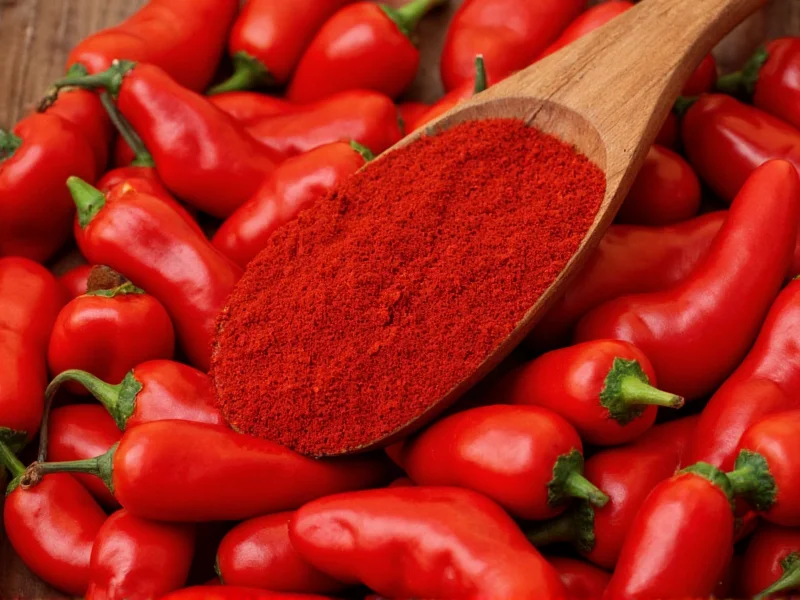Understanding paprika's heat level is essential for home cooks and culinary professionals alike. This vibrant red spice, made from ground peppers in the Capsicum annuum family, varies dramatically in heat depending on the specific pepper varieties used and regional production methods. Unlike many assume, not all paprika delivers a spicy kick—in fact, most common supermarket varieties are completely mild.
Understanding Paprika Heat Varieties
Paprika isn't a single standardized product but rather a category of spice with significant regional variations. The heat level depends entirely on which pepper varieties are used in production:
- Sweet paprika – Made from mild, sweet peppers with zero heat (0-500 SHU)
- Hot paprika – Contains spicy pepper varieties (5,000-15,000 SHU)
- Smoked paprika – Heat varies by type (sweet, medium, or hot)
| Paprika Type | Scoville Heat Units | Comparable Heat Level |
|---|---|---|
| Sweet Hungarian Paprika | 0-500 SHU | No heat, purely flavorful |
| Regular Hot Paprika | 5,000-10,000 SHU | Milder than cayenne (30,000-50,000 SHU) |
| Extra Hot Paprika | 10,000-15,000 SHU | Approaching mild cayenne heat |
| Spanish Smoked Paprika (Dulce) | 0-500 SHU | Sweet with smoky flavor |
| Spanish Smoked Paprika (Picante) | 5,000-8,000 SHU | Moderately spicy with smoke |
Regional Differences in Paprika Heat
The question how hot is Hungarian paprika has a specific answer: traditional Hungarian paprika is predominantly sweet with minimal heat (0-500 SHU). Hungary produces eight distinct paprika varieties, only two of which (Erős and Erős Csípős) contain noticeable heat.
Spanish paprika (pimentón) shows greater heat variation. While pimentón dulce is completely mild, pimentón picante delivers moderate heat (5,000-8,000 SHU). The smoking process used in Spanish paprika production doesn't affect heat level—smoked paprika can be either sweet or hot.
Factors Affecting Paprika Heat Level
Several elements determine how hot is paprika in your kitchen:
- Pepper selection – Producers blend different pepper varieties to achieve desired heat
- Processing method – Seeds and membranes contain most capsaicin; their inclusion increases heat
- Regional standards – Hungarian regulations limit heat in traditional paprika
- Storage conditions – Heat diminishes over time, especially when exposed to light and air
Identifying Heat Level When Shopping
Since packaging labels can be confusing, look for these indicators of how hot is paprika you're purchasing:
- Color intensity – Darker red often indicates higher quality but not necessarily more heat
- Label descriptors – "Dulce" (sweet), "Agridulce" (bittersweet), "Picante" (spicy)
- Country of origin – Hungarian typically mild, some Balkan varieties hotter
- Ingredient list – Pure paprika should contain only ground peppers
Culinary Applications by Heat Level
Understanding paprika heat levels helps you use this versatile spice effectively:
Sweet paprika (0-500 SHU) works beautifully in dishes where you want color and pepper flavor without heat—think deviled eggs, potato salads, and traditional Hungarian goulash. This variety answers the common question is paprika spicy in recipes with a definitive "no" when using sweet types.
Hot paprika (5,000-15,000 SHU) adds both color and noticeable heat to chorizo, certain stews, and spice rubs. When substituting hot paprika for cayenne, use 3-4 times the amount since cayenne is significantly hotter (30,000-50,000 SHU).
Professional chefs often blend sweet and hot paprika to achieve balanced flavor profiles. The question how hot is smoked paprika depends on the specific product—smoking adds flavor dimension but doesn't inherently increase heat.
Storage Tips to Maintain Quality
To preserve both flavor and (where applicable) heat level:
- Store in airtight container away from light and heat
- Use within 6 months for optimal flavor (heat diminishes faster than flavor)
- Refrigeration extends shelf life but may cause clumping
- Freezing maintains potency for up to one year
Common Substitutions When Paprika Isn't Available
If you're wondering what can I use instead of paprika, consider these alternatives based on the heat level you need:
- For sweet paprika – A pinch of cayenne with tomato paste for color
- For hot paprika – Equal parts chili powder and a touch of cumin
- For smoked paprika – Chipotle powder diluted with sweet paprika
Frequently Asked Questions
Is all paprika spicy?
No, most common paprika varieties are completely mild. Sweet paprika (0-500 SHU) has no heat, while only specific "hot" varieties deliver noticeable spice (5,000-15,000 SHU). Hungarian paprika is typically mild, while some Balkan and specialty varieties can be hotter.
How does paprika heat compare to cayenne pepper?
Paprika is significantly milder than cayenne. While hot paprika reaches 5,000-15,000 Scoville units, cayenne measures 30,000-50,000 SHU. You would need 3-4 times more hot paprika to match cayenne's heat level in recipes.
Does smoked paprika have more heat than regular paprika?
No, the smoking process doesn't increase heat. Smoked paprika comes in sweet (0-500 SHU), medium, and hot (5,000-8,000 SHU) varieties, similar to regular paprika. The smoke adds flavor complexity but doesn't affect the Scoville rating.
Why is my paprika not spicy when recipes say it should be?
You likely have sweet paprika, which contains no heat. Check your container for descriptors like "dulce," "sweet," or "mild." For spicy applications, look specifically for "hot," "picante," or "erős" on the label. Hungarian paprika is traditionally mild unless labeled as hot variety.
How can I tell if paprika has gone bad?
Faded color, loss of aroma, and clumping indicate degraded paprika. While it won't make you sick, old paprika loses both flavor and (in hot varieties) heat. Properly stored in an airtight container away from light, paprika maintains quality for 6-12 months. Discard if you notice any mold or off odors.











 浙公网安备
33010002000092号
浙公网安备
33010002000092号 浙B2-20120091-4
浙B2-20120091-4